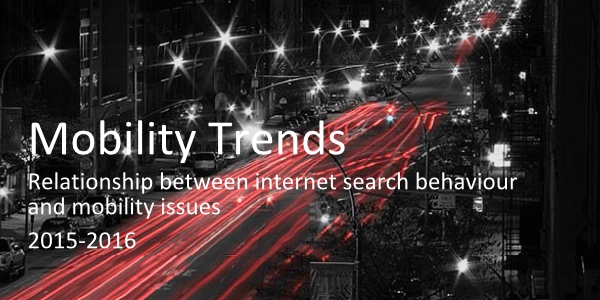Mobility Trends

Companies around the world have recognised that it is critical for success to use information about users’ search behaviour for their own company decisions. The fact that search queries can also be used to make statements about social phenomena has been known at the latest since the introduction of Google Trends. The aim of the Mobility Trends project was to explore whether it is possible to derive connections between the search behaviour of people in internet search engines and traffic and mobility relevant questions and make them usable for the traffic and mobility community.
Client: bmvit, mobility of the future 4th call for tenders
Duration: March 2015 to February 2016 (12 months)
Project partner: pn-venture GesmbH
Project description: Every day millions of internet users around the world search online for a wide variety of information on a wide range of topics, including transport and mobility. The type and frequency of search queries allows conclusions to be drawn about the actual behaviour of people in many subject areas. Companies worldwide have therefore already discovered that it is critical to their success to use information about the search behaviour of users for corporate decisions. Companies actively use data from the most popular search engines (such as Google, Yahoo, Lycos, Atotco, Bingo etc.) to predict actual behaviour. These are “forecasts of the present” (and less of the future), as these previews can be used primarily to explain current or very near-future phenomena. However, since the introduction of Google Trends it has been known that search queries can not only be used to make forecasts for companies but also to make statements about social phenomena. In particular, the so-called Google flu trends play a pioneering role. On the basis of search queries on the subject of health, forecasts of the actual number of people suffering from influenza are made.
The aim of the Mobility Trends project was to explore whether it is possible to derive connections between the search behaviour of people in internet search engines and traffic and mobility issues and to make them usable for the traffic and mobility community. It analysed under which conditions and framework conditions this would be possible, for which target groups this innovative information could be of interest and how the range of transport and mobility solutions could be improved if these results were to be taken into account in future decisions by all possible stakeholders (e.g. local authorities, public transport providers etc.). Since no attempt has ever been made to apply the findings of big-data research to issues in the field of transport and mobility, this project is a groundbreaking attempt to generate innovative information that supports and qualitatively enhances the traditional methods and procedures for decision support of decision-makers (either in politics and administration and/or in transport companies).
Contact: Alex Schubert
